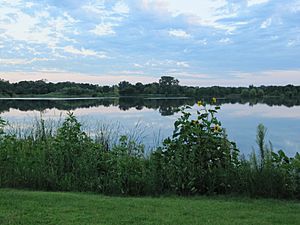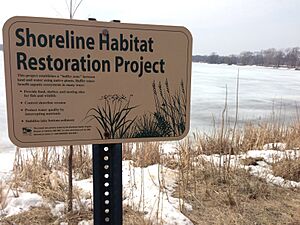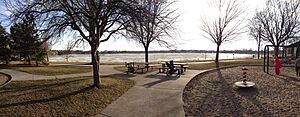Lake Hiawatha facts for kids
Quick facts for kids Lake Hiawatha |
|
|---|---|

Lake Hiawatha in July 2010
|
|
| Location | Minneapolis, Minnesota, United States |
| Coordinates | 44°55′15″N 093°14′11″W / 44.92083°N 93.23639°W |
| Primary inflows | Minnehaha Creek |
| Primary outflows | Minnehaha Creek |
| Basin countries | United States |
| Surface area | 53.5 acres (217,000 m2) |
| Max. depth | 33 ft (10 m) |
| Surface elevation | 814 ft (248 m) |
| Frozen | winter |
Lake Hiawatha is a lake located in Minneapolis, Minnesota. It sits just north of Lake Nokomis. The Minneapolis Park and Recreation Board bought the land for the lake in 1922. At that time, it was a marshy area known as Rice Lake. Over four years, the park system worked to change this wetland into the lake and park we know today.
Contents
Fun Things to Do at Lake Hiawatha
The lake and its park offer many activities for everyone. You can find a fishing dock, a wading pool, and tennis courts. There are also softball fields for games. A recreation center at the park hosts different activities throughout the year.
The lake is next to a city golf course. In winter, the golf course has trails for cross-country skiing. The park also has ice and hockey rinks for skating. A path about 0.68-mile (1.09 km) long runs along the east side of the lake. This path connects to the Grand Rounds trail system. From there, you can reach places like Lake Nokomis, Minnehaha Creek, and Minnehaha Falls. Lake Hiawatha is one of the few lakes that Minnehaha Creek flows through. It is the last lake the creek passes before reaching Minnehaha Falls and then the Mississippi River.
Helping Lake Hiawatha
Friends of Lake Hiawatha is a group of people from the community who care about the environment. They organize volunteers to help clean up the lake and the park. Their efforts help keep the area beautiful and healthy for everyone.
Fish in the Lake
Lake Hiawatha is home to many kinds of fish. Some of the fish you might find include black bullhead, black crappie, bluegill, and largemouth bass. Other fish species are northern pike, walleye, and yellow perch.
Sometimes, there are special warnings about eating certain fish from the lake. For example, it's suggested to limit how much bluegill and northern pike you eat. This is because tiny amounts of chemicals like mercury or PCBs have been found in them.
Lake Water Quality
Lake Hiawatha often has more litter than other lakes in Minneapolis. This is partly because it collects stormwater runoff from nearby neighborhoods. These areas include Corcoran, Central, Bryant, and Northrop, as well as the park's golf course. Stormwater can carry garbage and pollution into the lake.
The beach at Lake Hiawatha has sometimes been closed. For example, in August 2014, it was closed because of unsafe levels of E. coli bacteria. These bacteria can make people sick. Since 2010, Lake Hiawatha has also been officially infested with zebra mussels. These are small, invasive mussels that can harm the lake's ecosystem.
History of the Golf Course
The land that was once the Rice Lake marsh was dug out to a depth of 33 feet. The soil removed from the lake was used to create the rolling hills where the golf course was built. The golf clubhouse was finished in 1932, and the first 9 holes of the golf course opened in July 1934. The full 18-hole course opened the next summer.
The golf course quickly became very popular with people living in Minneapolis. For many years, it was the only golf course run by the Minneapolis Park Board that made a profit. The soil used to build the course tended to settle and sink. This meant repairs were needed early on. In 1939, a project added walls along the shore to stop erosion. This was important because the newly dug shoreline was easily worn away by waves.
The Lake Hiawatha Golf Course was especially important for African-American golfers in the area. At that time, many other golf courses did not welcome them. This course was the home course for the Old Negro Golf League. It also hosted the Upper Midwest Bronze Golf Tournament for over 25 years. Many black golfers remember learning to play here with their fathers. They say the course has a special historical meaning for them. As Charles Rodgers, a golf coach, once said, "This is the only course that allowed black people to play 60 years ago."




